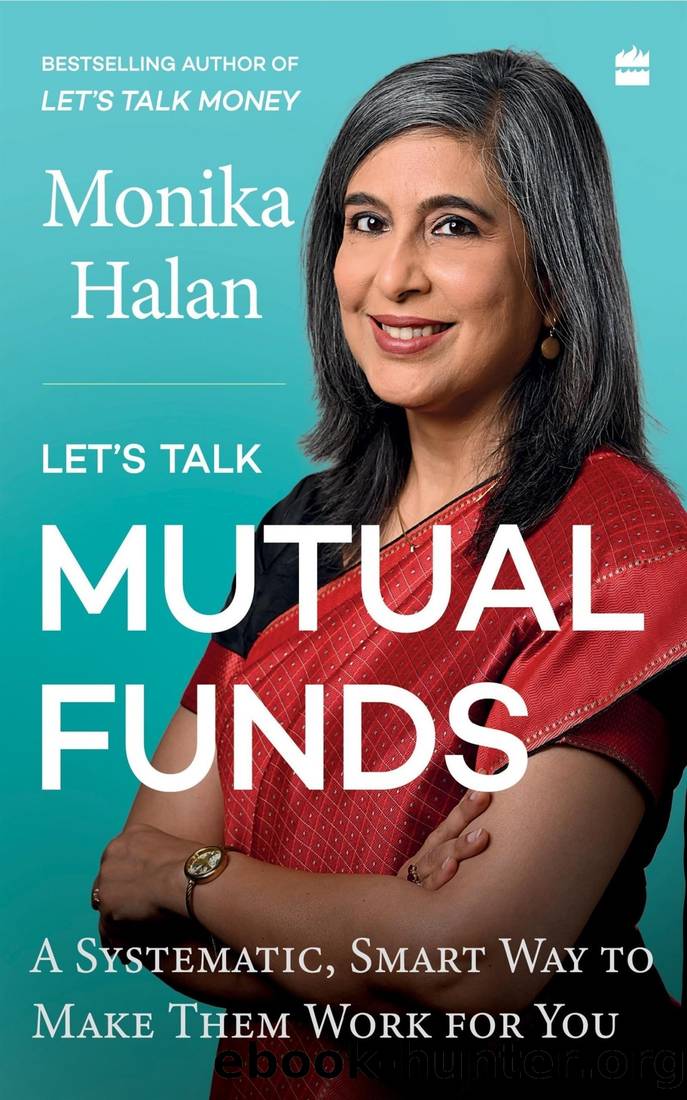Let's Talk Mutual Funds: A Systematic, Smart Way to Make Them Work for You by Monika Halan

Author:Monika Halan [Halan, Monika]
Language: eng
Format: epub
Tags: Business & Economics, Investments & Securities, General, Personal Finance, Investing, Money Management, Retirement Planning, Stocks, E-Commerce, Online Trading, Self-Help
ISBN: 9789356991354
Google: e2e_EAAAQBAJ
Amazon: B0C5FG9NQ2
Publisher: Harper Collins
Published: 2023-06-26T18:30:00+00:00
If investors had access to the new Risk-o-Meter earlier, they might not have bought into these debt funds thinking they are just moderately risky rather than being very high on the risk metric.
Using the Risk-o-Meter
All equity schemes are marked as high risk and very high risk. Investors understand that this is a risky asset class. The real value of the Risk-o-Meter is in evaluating debt funds. Counterintuitively, debt funds can be riskier than equity funds in some cases. Evaluating risk is very difficult for a retail investor or even advisorsâthis is something credit rating agencies and bond fund research desks might do well. But what you can do is look for Risk-o-Meter reading for the shortlisted schemes in your debt portfolio. Choose low risk in debt. Do not make the error of bringing home the risk into the debt part of your portfolio. Do not shoot for the highest return in debt. Stay with a low risk rating of 1 and 2. Check the risk rating at least four times in a year so that you donât get a shock. Have the link to the page on AMFI or your fund house that displays the Risk-o-Meter handy so that every few months you donât have to search for this.
But the chances of a repeat of the excesses of 2015â20 are low because SEBI has also made the categories truer to label than before. The chances of funds stuffing longer maturity funds in the low maturity category are now much lower. So, both the Risk-o-Meter and the new categorization make debt funds a much safer option than they were before.
Remember that fund houses will find ways to spot a loophole and stuff higher risk paper or strategies just to show higher returns to attract investors. If there is a big outlier in terms of returns in a particular category, be sure to examine its risk metrics very carefully.
One last thing you can do to manage the risk in your portfolio. Link the risk metric to your holding period. Any money you need within three years must have a low or low to moderate risk reading on the Risk-o-Meter. Medium-term money that you need between three to seven years must have low to moderate or moderate risk. Holding periods of more than seven years you go from moderately high to very high risk. The longer the holding period, the more risk you can take; the closer to today the need for money, lower is the risk.
Risk is not something you can avoid, so it is best to make friends with it and accept a reasonable risk approach rather than go blindly into negative real return products that do not give your money the growth over time that it needs to keep you funded in your later years. We are living longer and longerâweâll need our retirement pots to be large and inflation proof.
The next stop is at the tax station. Not something we like to give, but taxes cannot be avoided. There are asset classes and options that reduce your tax impact.
Download
This site does not store any files on its server. We only index and link to content provided by other sites. Please contact the content providers to delete copyright contents if any and email us, we'll remove relevant links or contents immediately.
| Analysis & Strategy | Bonds |
| Commodities | Derivatives |
| Futures | Introduction |
| Mutual Funds | Online Trading |
| Options | Portfolio Management |
| Real Estate | Stocks |
Rich Dad Poor Dad by Robert T. Kiyosaki(6398)
Pioneering Portfolio Management by David F. Swensen(6226)
How To Win Friends and Influence People by Dale Carnegie(4441)
The Money Culture by Michael Lewis(4073)
The Dhandho Investor by Mohnish Pabrai(3698)
The Wisdom of Finance by Mihir Desai(3649)
Liar's Poker by Michael Lewis(3367)
Fooled by Randomness: The Hidden Role of Chance in Life and in the Markets by Nassim Nicholas Taleb(3043)
The ONE Thing by Gary Keller(3007)
The Intelligent Investor by Benjamin Graham Jason Zweig(2995)
Mastering Bitcoin: Programming the Open Blockchain by Andreas M. Antonopoulos(2980)
How to Day Trade for a Living: Tools, Tactics, Money Management, Discipline and Trading Psychology by Andrew Aziz(2909)
Rich Dad Poor Dad: What The Rich Teach Their Kids About Money - That The Poor And Middle Class Do Not! by Robert T. Kiyosaki(2907)
Investing For Dummies by Eric Tyson(2893)
How to Win Friends and Influence People by Dale Carnegie(2860)
Market Wizards by Jack D. Schwager(2643)
Zero Hour by Harry S. Dent Jr. & Andrew Pancholi(2614)
How to Pay Zero Taxes, 2018 by Jeff A. Schnepper(2591)
The Psychology of Money by Morgan Housel(2590)
